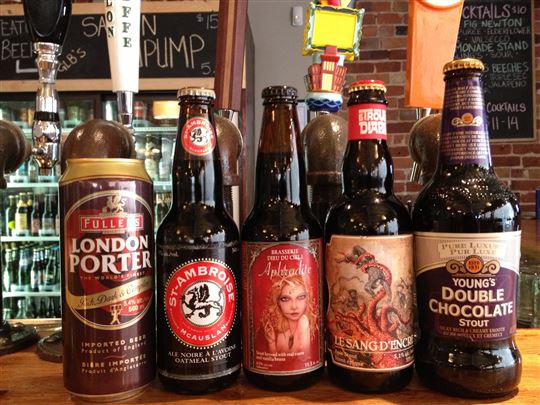Porter Vs. Stout: Or, Is There a Versus?

It’s that time of year again; the leaves are a beautiful warm spectrum of yellow, orange and red. You can smell the wood-burning stoves heating the houses in the crisp autumn air. Pumpkin everything is available everywhere (including spiced lattes and special micro-brews). You can wear your favourite cozy sweaters again. Now, and throughout the winter months to come, you can begin (or continue) ‘legitimately’ drinking comforting porters and stouts– not that you ever stopped drinking these dark, delicious beers. It just feels more appropriate now.
Wait…..is there difference between a stout and a porter? Ah, but that is the question. Let’s investigate this further, shall we? (Grab yourself a porter/and or stout while you read along….it’ll be way more fun, we promise.)
Historically speaking, the development of porter and stout are closely intertwined. The porter is a dark, well-hopped style of brown beer made from brown malts originating from 18th century London. Its name is largely responsible from its popularity amongst the river porters during that era. Porter brewers began to brew much stronger, roastier versions of the porter, which at the time were called stout porters. Over time, “porter” was dropped from the name, and the style simply became known as stout”.
Generally speaking, classic London porters tend to pour brown and over-all seem sweeter on both the palate and the nose (in comparison to classic stouts).
Stouts are brewed with un-malted barley, and roasted at a higher temperature to a blackened state. This method of brewing contributes to their sometimes pitch-black hues and roasted coffee with dark chocolate nuances.
Today, the modern stouts and porters have their own ‘sub-styles’ which can be fun to discover and help differentiate the main characteristics between each.
Beginning with the classic style of London porters, they tend to have a caramel malty sweetness upfront, balanced by hop bitterness on the finish. The American style of a porter will generally have more hop bitterness in comparison to its British version. Baltic porters tend to be a boozier, sweeter and more robust style of porter. During 18th century London, these styles of porters were made stronger for preservation purposes while being shipped off to Northern European countries (ie. Latvia, Finland, Poland, Estonia, Russia and Lithuania).
The stout ‘family’ also has its own range of styles to explore. The dry stouts (think Guiness) typically have a robust coffee aroma on the nose supporting a dry and bitter palate. Just as the name of the style is self-descriptive, sweet stouts (including milk stouts…..mmmmmmm!) can be just as they sound- sweet, and ‘milky’ in addition to their roasted coffee-like base. Oatmeal stouts often have a smooth texture, thanks to the oatmeal they are brewed with. These styles of stouts are only to name a few, as we could be here all day exploring the multitude of various styles. We suggest that you do your homework by grabbing a couple of different styles and taste the difference(s) yourself. Time to bust out your cardigans and classical music alongside your stout or porter style beer of choice; it’s a tough job, but somebody has to do it! Cheers!
Written by Kristin Perrin
Originally posted for Brother Bistro Blog
References:
The Oxford Companion to Beer by: Garrett Oliver

No comments yet.